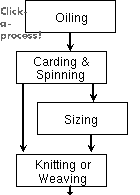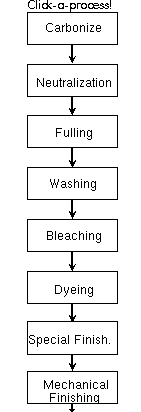

| PROCESS | INPUTS | WASTES | ||||
|---|---|---|---|---|---|---|
| Raw materials | Water | Energy | Liquid | Solid | Gas | |
| Wool Top, Olive Oil (1) | Electricity | (1) | ||||
| Electricity | N.A. | |||||
| Starch | See Table 2.1 | Electricity | See Table 2.2 | |||
| (2) | Electricity Steam | Vapours | ||||
(1) Although the oiling step does not contribute directly to the waste water volume, the oil finds its way into the waste stream through the washing after fulling operation. According to Jones, [8], the traditional oiling agent is olive oil, which produces a high BOD that could contribute 10% of the total BOD load.
(2) Weaving is a dry process but it is normally done in buildings maintained at high humidity. Cooling water and humidifying water used in greige mills represent a substantial portion of the total water usage [10].

| PROCESS | INPUTS | WASTES | ||||
|---|---|---|---|---|---|---|
| Raw materials | Water | Energy | Liquid | Solid | Gas | |
| H2SO4 (1) | 30 m3 [10] | (1) | (1) | Fine carbon particles (2), Fumes (SOx), Organic Decomposition Products | ||
| Na2CO3 | N.A. (5) | pH 2-9, BOD 1.7-2.1 Kg [8], TS 1250-4800ppm (5), FLOW 50-65 m3 | ||||
| (4) | N.A. (5) | N.A. | (4) | |||
| Soap Synthetic Detergent | N.A. (5) | Electricity Steam | pH 7.3-10.3, BOD 31-94 Kg [8], TS 4800-19300 ppm (5), FLOW 160-400 m3 | |||
| SO2 or H2O2 | N.A. (5) | Electricity, Steam | pH 6.0, BOD 1.4 Kg [8], TS 908 ppm (5), FLOW 1-11 m3 | |||
| Acid or Metalized dye (3) See Tables 9,10 | N.A. (5) See Table 8 | Electricity, Steam | pH 4.8-8.0 BOD 9.0-34.3 Kg [8], TS 3800-8300 ppm (5), FLOW 8-11 m3 | Vapours | ||
| (6) | N.A. (5) | N.A. | (5),(6) | Vapours Particulate | ||
| N.A. | Particulate | |||||
(1) Carbonizing is applied only if the greige goods are 100% wool. According to reference [8], it produces some solid waste but little liquid waste.
(2) According to Lund [12], this process generates very fine carbon particles which appear as smoke, as well as some fumes and odors. These fumes probably include residual sulfur oxides, if sulfuric acid has been used for carbonizing, as well as organic decomposition products and are generally corrosive [12].
(3) In accordance with Jones [8], these are the two classes of dyes used on wool fibre.
(4) There are two common methods of fulling: alkali fulling and acid fulling. In the former case, soap or synthetic detergent, soda ash and sequestering agent are used in the fulling solution; in acid fulling, fabric is impregnated with an aqueous solution of H2SO4, H2O2 and minor amounts of metallic catalyst (chromium, copper and cobalt). In either case, the water is heated to a temperature of 30-45 degC. Acid fulling is always followed by alkali fulling [8]. Little waste is generated since the fulling solution remains in the cloth [8] [12].
(5)Data for water consumption in the different stages is not available. See Table 6.1 for water use in a Wool Finishing Mill.
(6) The only dry finishing operation of concern for waste generation is moth-proofing [10].Table 2.3 shows the wastewater discharged if a permethrin-based mothproofing agent is used.
| Minimum | Median | Maximum |
|---|---|---|
| 110.9 | 283.6 | 657.2 |
| Units | BOD | COD | TSS | O&G | Phenol | Cr | Sulphide |
|---|---|---|---|---|---|---|---|
| mg/l | 300 | 1040 | 130 | - | 0.5 | 4.0 | 0.1 |
| Kg/t | 59.8 | 204.8 | 17.2 | N.A. | N.A. | N.A. | N.A. |
| Method | Permethrin Load (g) | Wastewater discharge (m3) |
|---|---|---|
| Hank Dyebath | 8.0 | 50 |
| Conventional tape scour | 30.0 | 0.75 |
| Mini-bowl tape scour | 4.0 | 0.1 |
| Modified centrifuge | 1.7 | 0.05 |